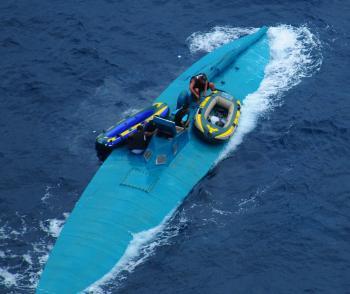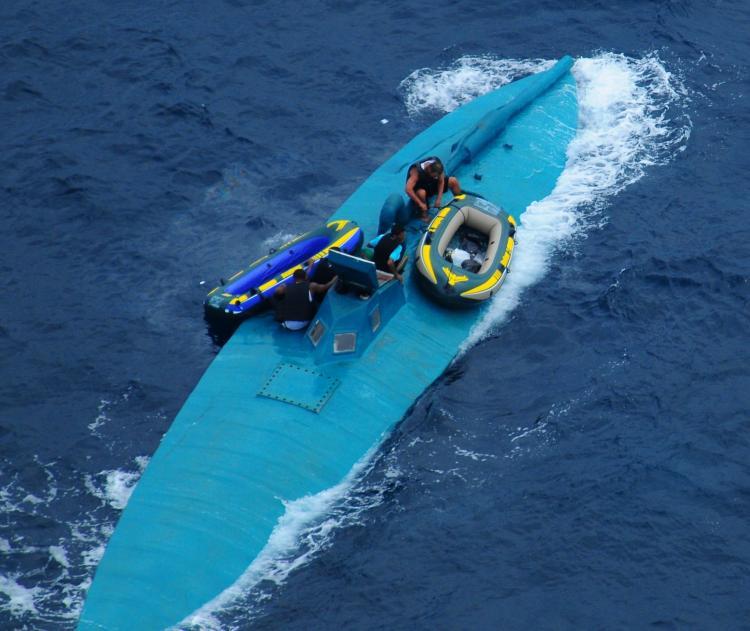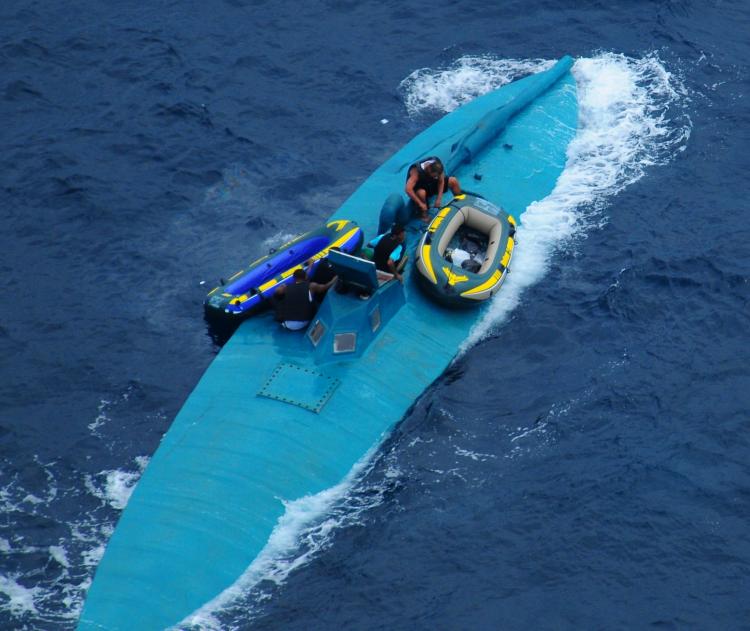As part of U.S.-led multinational counter-drug efforts in the Caribbean and Eastern Pacific, Canada’s armed forces helped stop $272 million worth of cocaine from entering North America in the first two months of 2009.
The most recent drug bust involving the Canadian Forces took place on February 9 in the Caribbean Basin off the northeastern coast of South America.
The Halifax, Nova Scotia-based HMCS Montréal frigate helped a French warship intercept a go-fast boat that was carrying 600 kilograms of cocaine.
The FV Ventose delivered the smugglers and the cocaine, valued at $30 million, to police on the French island of Martinique.
A month earlier, the Canadian Forces assisted a drug bust that was eight times greater in value.
On January 15, a CP-140 Aurora long-range patrol aircraft, based in Comox, British Columbia, helped the U.S. Coast Guard identify and track a self-propelled semi-submersible (SPSS) vessel in the Pacific Ocean off the coast of South America.
The SPSS was carrying seven metric tonnes (about 7,000 kilograms) of cocaine worth $242 million.
Both missions were part of Operation Caribbe, the Canadian Forcers’ codename for its participation in an international partnership that aims to reduce drug trafficking and other illegal activities in the Caribbean and Eastern Pacific.
In the partnership, Canada works with the U.S., U.K., France, Spain, and the Netherlands under the U.S.-led Joint Interagency Task Force South (JIATF-S), an organization led by the U.S. Southern Command within the U.S. Department of Defense.
Operation Caribbe is led by Canada Command, a Canadian Forces organization responsible for routine and contingency operations in Canada and North America.
Since November 2006, Canada Command has been supporting the work of JIATF-S by providing warships, submarines, and long-range maritime patrol aircraft to help detect and track illicit activities.
“One of the goals of the Canada First Defence Strategy is for Canada to be a strong and reliable partner in the defence of North America. Operation Caribbe is an example of this commitment in action,” said Peter MacKay, Minister of National Defence and Minister of the Atlantic Gateway, in a news release.
The Canada First Defence Strategy, announced by the federal government in May 2008, committed long-term funding and set out roles and missions for the Canadian Forces for domestic, North American, as well as overseas operations.
Collaborating with the U.S. military, international allies, and intelligence and law enforcement agencies such as the FBI, U.S. Coast Guard, and U.S. Drug Enforcement Administration, both in 2007 and 2008 the JIATF-S stopped more than 200 metric tonnes of cocaine from reaching Canada and the U.S. from the southern approaches to North America.
In recent years, SPSS vessels have become more advanced in range and capacity and are increasingly being used to smuggle large quantities of cocaine from South and Central America to North America.
U.S. officials estimate that SPSS vessels are used in 32 percent of all narcotics shipments in the Western Hemisphere Transit Zone, which includes the Caribbean and Eastern Pacific.
With their hull rising only about half a metre (18 inches) above the waterline, these low-profile vessels are hard to see from a distance, leave little wake, and are difficult to detect with radar.
While operating in the Caribbean in January, HMCS Montréal became the first naval ship to conduct trials with SPSS vessels. The trials were a first step toward developing tactics and procedures that will help in the detection and tracking of SPSS vessels.
SPSS vessels range from 12 to 30 metres (40 to 100 feet) in length and can carry four to five crew members and as many as twelve metric tonnes of cocaine.
A growing concern is that these vessels can potentially be used by criminal organizations and even terrorists to carry other kinds of illicit cargo.
“What worries me [about the SPSS] is if you can move that much cocaine, what else can you put in that semi-submersible. Can you put a weapon of mass destruction in it?” said Navy Admiral Jim Stavridis, Commander of the U.S. Southern Command, as quoted on the Southern Command website.
While cocaine is the largest type of trafficking that JIATF-S deals with, the organization is also responsible for coordinating efforts to stem other illicit activities such as piracy, the smuggling of humans, money, and weapons, and terrorism.
The most recent drug bust involving the Canadian Forces took place on February 9 in the Caribbean Basin off the northeastern coast of South America.
The Halifax, Nova Scotia-based HMCS Montréal frigate helped a French warship intercept a go-fast boat that was carrying 600 kilograms of cocaine.
The FV Ventose delivered the smugglers and the cocaine, valued at $30 million, to police on the French island of Martinique.
A month earlier, the Canadian Forces assisted a drug bust that was eight times greater in value.
On January 15, a CP-140 Aurora long-range patrol aircraft, based in Comox, British Columbia, helped the U.S. Coast Guard identify and track a self-propelled semi-submersible (SPSS) vessel in the Pacific Ocean off the coast of South America.
The SPSS was carrying seven metric tonnes (about 7,000 kilograms) of cocaine worth $242 million.
Both missions were part of Operation Caribbe, the Canadian Forcers’ codename for its participation in an international partnership that aims to reduce drug trafficking and other illegal activities in the Caribbean and Eastern Pacific.
In the partnership, Canada works with the U.S., U.K., France, Spain, and the Netherlands under the U.S.-led Joint Interagency Task Force South (JIATF-S), an organization led by the U.S. Southern Command within the U.S. Department of Defense.
Operation Caribbe is led by Canada Command, a Canadian Forces organization responsible for routine and contingency operations in Canada and North America.
Since November 2006, Canada Command has been supporting the work of JIATF-S by providing warships, submarines, and long-range maritime patrol aircraft to help detect and track illicit activities.
“One of the goals of the Canada First Defence Strategy is for Canada to be a strong and reliable partner in the defence of North America. Operation Caribbe is an example of this commitment in action,” said Peter MacKay, Minister of National Defence and Minister of the Atlantic Gateway, in a news release.
The Canada First Defence Strategy, announced by the federal government in May 2008, committed long-term funding and set out roles and missions for the Canadian Forces for domestic, North American, as well as overseas operations.
Collaborating with the U.S. military, international allies, and intelligence and law enforcement agencies such as the FBI, U.S. Coast Guard, and U.S. Drug Enforcement Administration, both in 2007 and 2008 the JIATF-S stopped more than 200 metric tonnes of cocaine from reaching Canada and the U.S. from the southern approaches to North America.
In recent years, SPSS vessels have become more advanced in range and capacity and are increasingly being used to smuggle large quantities of cocaine from South and Central America to North America.
U.S. officials estimate that SPSS vessels are used in 32 percent of all narcotics shipments in the Western Hemisphere Transit Zone, which includes the Caribbean and Eastern Pacific.
With their hull rising only about half a metre (18 inches) above the waterline, these low-profile vessels are hard to see from a distance, leave little wake, and are difficult to detect with radar.
While operating in the Caribbean in January, HMCS Montréal became the first naval ship to conduct trials with SPSS vessels. The trials were a first step toward developing tactics and procedures that will help in the detection and tracking of SPSS vessels.
SPSS vessels range from 12 to 30 metres (40 to 100 feet) in length and can carry four to five crew members and as many as twelve metric tonnes of cocaine.
A growing concern is that these vessels can potentially be used by criminal organizations and even terrorists to carry other kinds of illicit cargo.
“What worries me [about the SPSS] is if you can move that much cocaine, what else can you put in that semi-submersible. Can you put a weapon of mass destruction in it?” said Navy Admiral Jim Stavridis, Commander of the U.S. Southern Command, as quoted on the Southern Command website.
While cocaine is the largest type of trafficking that JIATF-S deals with, the organization is also responsible for coordinating efforts to stem other illicit activities such as piracy, the smuggling of humans, money, and weapons, and terrorism.






